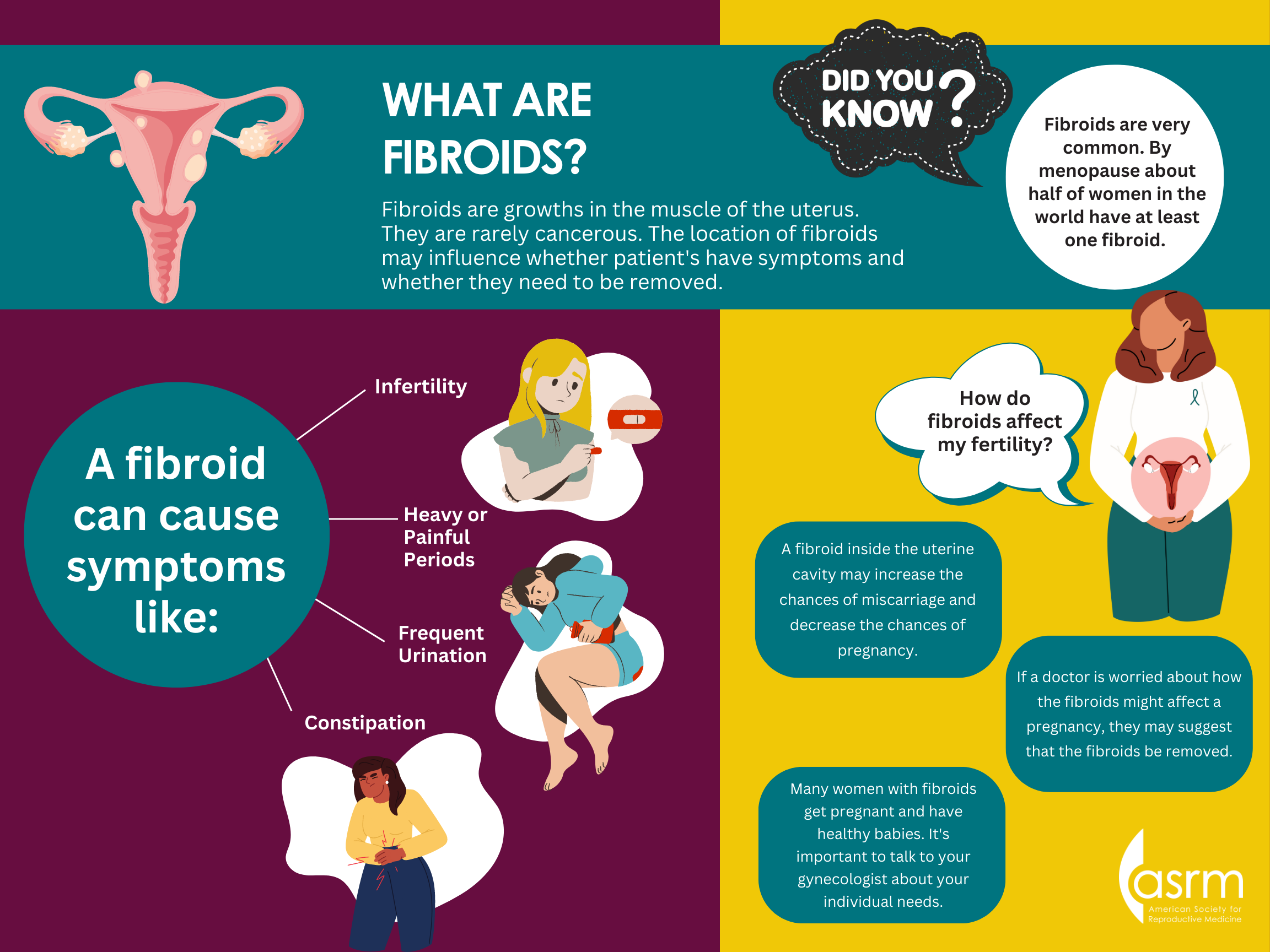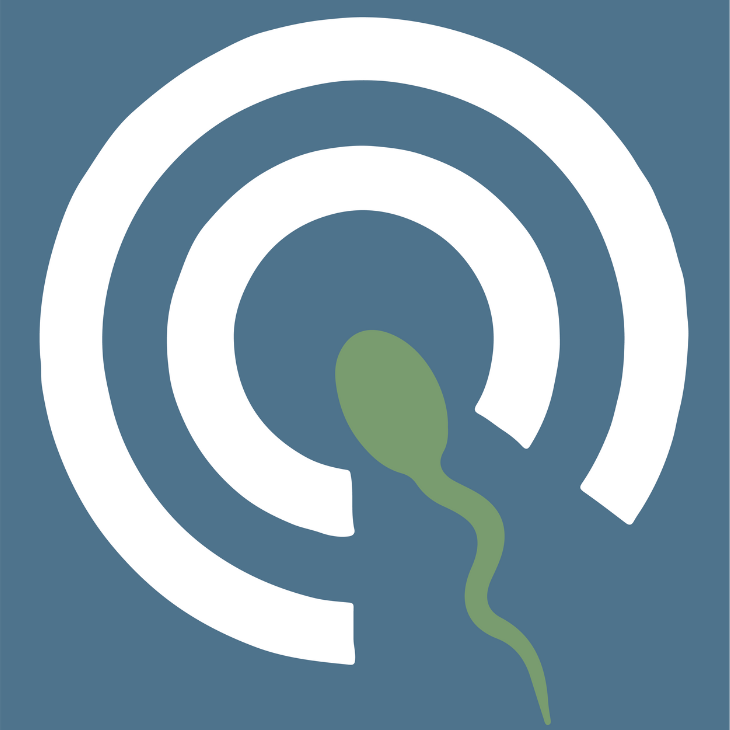
Revised 2023
What are fibroids?
Uterine fibroids (also called myomas or leiomyomas) are benign (non-cancerous) tumors of muscle tissue found in the uterus. They can enlarge and/or distort the uterus (womb) and sometimes the cervix (lower part of the uterus). They grow from the smooth muscle cells in the wall of the uterus.
Fibroids usually become noticeable during the reproductive years and become smaller after menopause. Most cause no symptoms and do not require treatment. However, depending on the size and location of the fibroids in the uterus, they may cause symptoms and require treatment.

What causes fibroids?
Fibroids happen when a genetically altered muscle cell in the wall of the uterus produces excessive muscle tissue, creating a mass that enlarges. The exact cause of fibroids is unclear, but evidence suggests that both genetics and hormones play roles. For instance, fibroids are slightly more common in African American females compared with Caucasian females. Estrogen and progesterone (hormones produced primarily by the ovaries) may stimulate growth of fibroids. After menopause, when hormone levels are low, fibroids rarely grow and frequently shrink. There is little evidence that nutritional, or lifestyle factors affect fibroid growth and development. Similarly, medications such as low-dose birth control pills have little or no impact on fibroid growth.

Where are fibroids found?
Fibroids are usually found within the inside, in the wall, or on the outside of the uterus, and typically can be divided into three categories:
- Subserosal are located in the outer wall of the uterus (55%).
- Intramural are found in the muscular layers of the uterine wall (40%).
- Submucosal protrude into the uterine cavity (5%).
Fibroids can also be connected to the uterus through a stalk (pedunculated), sometimes occur in the cervix, or can be attached to nearby organs such as the bladder and bowel, or to the ligaments surrounding the uterus. Fibroids are rarely found outside the pelvic cavity.
What kind of symptoms do fibroids cause?
Symptoms from fibroids are related to their size and location. Most women with uterine fibroids have no symptoms. The most common symptoms are abnormal uterine bleeding, pain, and pelvic pressure.
Abnormal uterine bleeding
Abnormal uterine bleeding is the most common symptom when fibroids are located in or near the inside lining of the uterus and is the main reason for requesting treatment for fibroids. Because abnormal uterine bleeding can be due to other conditions, such as endometrial cancer and hormonal problems, it is important that individuals with fibroids who experience abnormal vaginal bleeding undergo a thorough evaluation for other causes of bleeding.
Pain
A rapidly enlarging fibroid may outgrow its blood supply and degenerate, causing pain and cramping. Fibroids that are attached to the uterus by a thin stalk may twist and cause severe pain. Large uterine fibroids may also make sexual intercourse or certain actions painful. Individuals with fibroids may also experience painful menstrual cramps.
Pelvic pressure
Large fibroids may press on nearby pelvic organs. If the fibroid presses on the bladder, which lies in front of the uterus, urinary frequency or urgency may occur. Pressure on the ureters (the tubes that transport urine from the kidneys to the bladder) can result in kidney damage if the fibroids are not removed. Fibroids in the lower uterus may put pressure on the large bowel and rectum, which could cause painful bowel movements, constipation, hemorrhoids, or altered shape of stools.
Do fibroids cause infertility?
Individuals with fibroids can get pregnant and carry a pregnancy. However, fibroids can be associated with infertility. Achieving pregnancy in those with infertility can be more challenging in individuals with fibroids than in those without fibroids or who had their fibroids removed. In addition, for those who undergo in vitro fertilization (IVF), pregnancy success rates may be lower in when fibroids are present. The location of where the fibroids develop may be a factor in their role in infertility, with those protruding into the cavity (submucosal) and those in the muscular layer (intramural) causing more problems. See ASRM factsheet “Fibroids and Fertility.”
What happens to fibroids during pregnancy?
Fibroids may grow in pregnancy and may change how the baby is positioned at the time of delivery. In addition, fibroids increase the risk for a cesarean section, miscarriage, and premature delivery. Depending on where the fibroids are located, they can also lead to problems during delivery, including bleeding and premature separation of the placenta from the uterus (womb).
Can fibroids be cancerous?
The overall risk of fibroids being cancerous is approximately 1 in 1,000 (of removed fibroids) in the reproductive years and is more common after menopause. Cancers arising from uterine fibroids are called leiomyosarcomas. A fibroid that grows after menopause may be a leiomyosarcoma, in which case removal of the uterus (hysterectomy) is required.
How are fibroids diagnosed?
Pelvic exam
Uterine fibroids are often found on pelvic exam by assessing the shape and size of the uterus. Sometimes a pelvic exam alone may not be enough to distinguish a fibroid from an ovarian mass close to the uterus. In addition, smaller fibroids may not be found on pelvic exams. Imaging studies, like ultrasound, may be used to confirm the findings.
Ultrasound
Ultrasound uses the echoes from high-frequency sound waves to create a picture of the pelvic organs. Because fibroids vary in size and location, ultrasound across the abdominal wall and using a probe placed in the vagina may be used to best see the fibroids.
Sonohysterography
Sonohysterography (SHG), also called Saline infusion Sonohysterogram (SIS), is an ultrasound procedure in which the uterine cavity is filled with a small amount of fluid which is placed in the uterus through a thin plastic tube in the vagina. SHG improves the doctor’s ability to identify fibroids that protrude into or distort the uterine cavity. For more information about SHG, please see the ASRM fact sheet titled Saline infusion sonohysterography (SHG).
Magnetic Resonance Imaging (MRI)
Magnetic Resonance Imaging (MRI) uses magnetic fields to form images of the body. Once fibroids are diagnosed, an MRI may be helpful to identify their size and location in the uterus to determine the best treatment options.
Fibroids or Myomas or Leiomyomas
Fact Sheets/Booklets
View more fact sheets and booklets written by the ASRM Patient Education Committee.
Menopausal Transition (Perimenopause): What Is It?
The menopausal transition (perimenopause) is the period that links a woman’s reproductive (childbearing) years and menopause.
Osteoporosis
Osteoporosis and osteopenia are conditions of having low bone mass (density).
Hyperprolactinemia (High Prolactin Levels)
Prolactin is a hormone produced by your pituitary gland which sits at the bottom of the brain.Find a Health Professional











